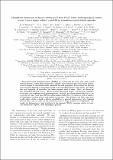Ubiquitous formation of bulk Dirac cones and topological surface states from a single orbital manifold in transition-metal dichalcogenides
Date
01/2018Author
Grant ID
PLP-2015-144
2016-006
EP/M023427/1
EP/I031014/1
UF120096
Metadata
Show full item recordAbstract
Transition-metal dichalcogenides (TMDs) are renowned for their rich and varied bulk properties, while their single-layer variants have become one of the most prominent examples of two-dimensional materials beyond graphene. Their disparate ground states largely depend on transition metal d-electron-derived electronic states, on which the vast majority of attention has been concentrated to date. Here, we focus on the chalcogen-derived states. From density-functional theory calculations together with spin- and angle-resolved photoemission, we find that these generically host a coexistence of type-I and type-II three-dimensional bulk Dirac fermions as well as ladders of topological surface states and surface resonances. We demonstrate how these naturally arise within a single p-orbital manifold as a general consequence of a trigonal crystal field, and as such can be expected across a large number of compounds. Already, we demonstrate their existence in six separate TMDs, opening routes to tune, and ultimately exploit, their topological physics.
Citation
Bahramy , M S , Clark , O J , Yang , B-J , Feng , J , Bawden , L , Riley , J M , Markovic , I , Mazzola , F , Sunko , V , Biswas , D , Cooil , S P , Jorge , M , Wells , J W , Leandersson , M , Balasubramanian , T , Fujii , J , Vobornik , I , Rault , J , Kim , T K , Hoesch , M , Okawa , K , Asakawa , M , Sasagawa , T , Eknapakul , T , Meevasana , W & King , P D C 2018 , ' Ubiquitous formation of bulk Dirac cones and topological surface states from a single orbital manifold in transition-metal dichalcogenides ' , Nature Materials , vol. 17 , no. 1 , pp. 21-28 . https://doi.org/10.1038/nmat5031
Publication
Nature Materials
Status
Peer reviewed
ISSN
1476-1122Type
Journal article
Description
Funding: Leverhulme Trust, the Engineering and Physical Sciences Research Council, UK (Grant Nos. EP/M023427/1 and EP/I031014/1), the Royal Society, OJC, LB, JMR and VS acknowledge EPSRC for PhD studentship support through grant Nos. EP/K503162/1, EP/G03673X/1, EP/L505079/1, and EP/L015110/1.Collections
Items in the St Andrews Research Repository are protected by copyright, with all rights reserved, unless otherwise indicated.

